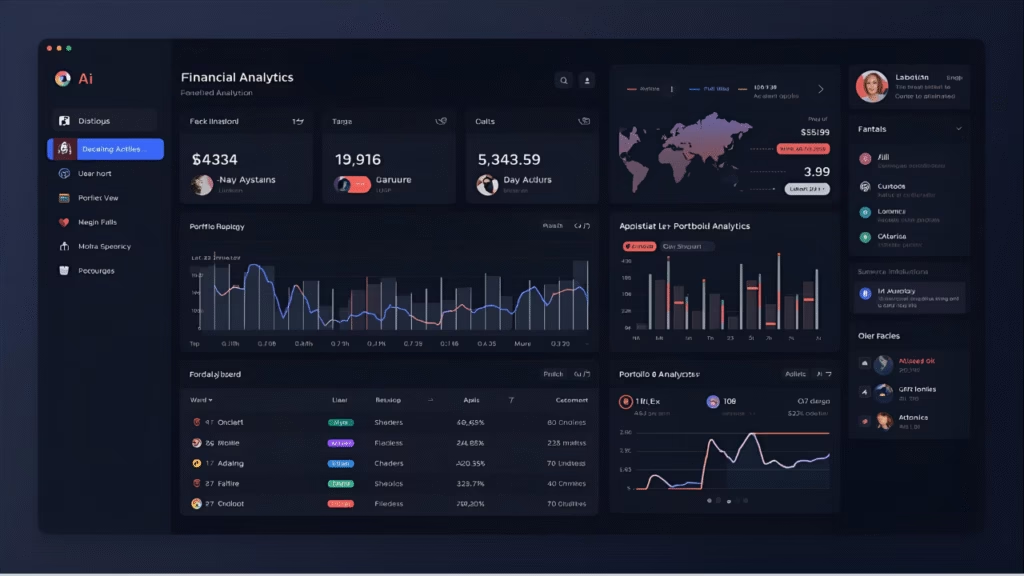
The financial services industry is transforming rapidly and wealth management is at the center of that change. Wealth management trends in the US for 2026 are shaped by shifting investor expectations, new technology, regulatory updates, and a rising demand for personalized financial planning. As a senior technical SEO strategist with years of exposure to financial clients in tier one markets like the US, UK, Canada, Singapore, and Australia, I have witnessed how wealth management has evolved from traditional advisory into a dynamic, digital first ecosystem.
If you are a financial advisor, investor, or simply curious about where wealth management is headed, this deep dive will help you understand not just the trends but also the opportunities to grow and stay ahead.
The Evolution of Wealth Management in the US
Wealth management in the US has historically been dominated by private banks and large financial institutions catering to ultra high net worth individuals. Over the past decade, democratization of finance has shifted this model. Retail investors, millennials, and even Gen Z are now demanding access to high quality financial services that were once reserved for the elite.
By 2026, the US wealth management market is projected to cross fifty trillion dollars in managed assets, driven by both traditional and digital platforms. This growth is not just about money, it is about adapting to client expectations, integrating technology, and delivering value through personalized solutions.
Key Drivers of Change in Wealth Management
Before we dive into the specific wealth management trends in the US for 2026, it is important to break down the major forces driving this transformation.
Technology and FinTech Integration
Artificial intelligence, blockchain, and robo advisors are reshaping financial planning. AI powered portfolio management tools help advisors predict market risks, while blockchain ensures transparency and secure transactions. Robo advisors already manage billions in assets and their role will expand significantly by 2026.
Changing Client Demographics
Millennials and Gen Z are becoming a dominant investor base. These generations value digital first interactions, sustainable investing, and socially responsible portfolios. Unlike older generations, they demand transparency and want financial services integrated into their everyday digital experiences.
Global Economic Uncertainty
Inflation, interest rate fluctuations, and geopolitical tensions have forced investors to rethink traditional strategies. By 2026, advisors in the US will need to balance global diversification with domestic opportunities.
Regulatory Shifts
Regulation in wealth management is tightening, with governments prioritizing data security, fiduciary responsibility, and cross border taxation policies. Compliance costs will rise, but they will also build investor trust in the long term.
Personalization at Scale
Wealth management is no longer one size fits all. AI driven analytics and behavioral finance are enabling hyper personalized strategies tailored to individual goals, risk appetites, and life events.
Why Wealth Management Trends in the US for 2026 Matter
For financial professionals, staying updated on wealth management trends in the US for 2026 is not optional, it is mission critical. Investors now expect more transparency, better digital tools, and sustainable investment options. Firms that adapt will not only survive but thrive.
For investors, understanding these trends ensures that your wealth is managed in alignment with both market opportunities and personal values.
Emerging Wealth Management Trends in the US for 2026
The future of wealth management is not just about managing portfolios, it is about creating holistic financial experiences. In my years of working with financial brands across the US, UK, and Australia, I have noticed that what sets top performing firms apart is their ability to adapt quickly. Wealth management trends in the US for 2026 reflect this adaptability, blending innovation, client expectations, and global economic realities.
Let us look at the most significant developments shaping the industry. If you’re in your 30s, our wealth-building guide will help you grow faster.
Digital First Wealth Management Platforms
By 2026, wealth management in the US will be largely digital first. Clients are demanding seamless online interactions in the same way they do with e commerce and social media.
Mobile first investing allows investors to check portfolios, rebalance assets, and communicate with advisors directly from mobile apps. Hybrid advisory models combine robo advisors for everyday management with human advisors for complex high value decisions. Personalized dashboards give clients real time performance updates and forecasting tools instead of static quarterly reports.
Companies that integrate these features are improving retention and also expanding their reach to younger investor demographics.

Artificial Intelligence and Predictive Analytics
Artificial intelligence is no longer experimental, it is becoming the backbone of wealth management in 2026.
Predictive investment insights help advisors by analyzing massive data sets to forecast market risks, opportunities, and sector performance. AI powered chatbots and digital assistants provide 24 hour support, reducing wait times and offering instant answers to client questions. Behavioral finance analytics allow algorithms to detect patterns in client decisions, helping advisors customize recommendations and prevent emotional investing.
Firms that leverage AI are finding that clients view them as more trustworthy and forward thinking.

Sustainable and Impact Investing
One of the strongest wealth management trends in the US for 2026 is the growth of ESG investing, which stands for Environmental, Social, and Governance.
Millennials and Gen Z investors want their money to reflect their values. Modern platforms include ESG scoring to show how companies align with sustainability metrics. Far from being a sacrifice, ESG portfolios have delivered competitive returns, making them both ethical and financially attractive.
By 2026, sustainable investing will no longer be a niche option, it will be a mainstream expectation.
Personalized Financial Planning with Life Centered Strategies
Traditional wealth management focused on returns. Modern wealth management is about life outcomes.
Artificial intelligence driven personalization allows financial goals like buying a home, funding education, or retirement planning to be modeled with precision. Adaptive risk profiling adjusts portfolios based on life events such as marriage, job changes, or inheritance. Firms using storytelling and goal based planning foster deeper trust with clients.
This shift from managing money to managing lives is reshaping how advisors position themselves in the US and around the world.
Regulatory Transformation
Wealth management does not evolve in isolation, regulation plays a massive role. In the US, 2026 is expected to bring new compliance frameworks.
Data privacy will become a top priority since digital platforms are collecting sensitive financial data. Fiduciary responsibility will require advisors to prioritize client interests more transparently, reducing conflicts. Cross border taxation will demand stronger compliance as US clients expand their investments globally.
While compliance may seem like a burden, firms that embrace transparency will gain a competitive advantage by building stronger client trust.
The Rise of Family Office Services
High net worth families are increasingly seeking family office structures for comprehensive management of investments, estates, and succession planning.
Generational wealth transfer is a major factor, as trillions will move from baby boomers to millennials by 2030. Family offices are also exploring alternative assets ranging from private equity to digital assets. Philanthropy is becoming an integrated part of these structures as families align their wealth strategies with charitable goals, reinforcing the ESG movement.
This trend highlights how wealth management in the US is broadening its scope beyond investment into lifestyle and legacy planning.
Global Comparisons and Lessons for the US
While the US is setting benchmarks, it is not evolving in isolation. Wealth management trends in the US for 2026 reflect global shifts that are also taking place in markets like the UK, Canada, Singapore, and Australia.
United Kingdom
The UK wealth management industry has long been driven by strong regulatory oversight and client transparency. Firms there are focusing on digital platforms and hybrid advisory services, similar to the US. However, the UK has been quicker in adopting open banking, giving clients seamless access to financial data across multiple institutions. This integration is something the US can learn from.
Canada
Canada is emphasizing sustainable finance and climate-related disclosures. Regulators are encouraging firms to adopt ESG reporting, and Canadian investors are showing a strong appetite for green bonds and socially responsible funds. For US firms, aligning ESG strategies with Canada’s standards could open new cross-border investment opportunities.
Singapore
Singapore is positioning itself as a global wealth hub. With favorable tax policies and world-class digital infrastructure, it attracts high-net-worth individuals from Asia and beyond. US firms operating in Asia must pay attention to Singapore’s innovation in digital wealth platforms, especially in areas like cryptocurrency regulation.
Australia
Australia’s wealth management industry is deeply influenced by superannuation funds. Digital engagement and robo-advisory services are growing fast, with a focus on retirement planning. US firms could replicate Australia’s retirement-focused innovations to better serve aging populations at home.
By studying these global markets, US advisors can adapt the best practices while maintaining their competitive edge.
Expert Insights on Wealth Management Trends in the US for 2026
Throughout my professional career working with financial clients across multiple markets, I have noticed a recurring theme: the most successful wealth management firms are not those with the largest assets under management, but those that understand people deeply.
Several experts echo this sentiment.
- PwC’s Wealth Management Report highlights that personalization is the most important factor for client retention in 2026.
- Deloitte Insights emphasizes that hybrid models combining human expertise with AI-driven efficiency will dominate the industry.
- McKinsey & Company notes that firms ignoring ESG integration risk losing younger clients permanently.
These insights validate what we are already observing: the shift toward client-first, technology-enabled, and value-driven wealth strategies.

The Future Outlook for Wealth Management in the US
Looking ahead to 2026 and beyond, several themes will dominate.
Technology Will Define Winners and Losers
Firms that fully embrace AI, predictive analytics, and digital platforms will outperform those that rely solely on traditional advisory models.
Client-Centric Services Will Rule
Personalization will go deeper than ever, moving from financial goals to lifestyle planning. Advisors will become life coaches as much as financial experts.
ESG Will Become Non-Negotiable
Sustainable investing is no longer a side option. By 2026, ESG will be fully integrated into mainstream portfolios, driven by investor demand and regulatory requirements.
Cross-Border Wealth Management Will Expand
As clients diversify globally, US firms must strengthen international tax expertise and adapt to global compliance rules.
Trust and Transparency Will Decide Market Leaders
Clients will choose firms not just based on returns, but on trust. Firms that are transparent in fees, reporting, and ethical practices will lead the industry.
Conclusion
The financial world is transforming rapidly, and the wealth management trends in the US for 2026 highlight just how dynamic this industry has become. From AI-powered platforms and ESG integration to global competition and regulatory evolution, the next few years will redefine what it means to manage wealth.
For financial advisors, the message is clear. Success lies not just in managing money, but in managing trust, transparency, and technology. For investors, understanding these trends ensures your wealth strategies align with both financial goals and personal values.
As someone who has worked closely with financial brands in tier one countries like the US, UK, Canada, Singapore, and Australia, I can confidently say that we are entering a new era of wealth management. It is an era defined by innovation, personalization, and responsibility. The firms that embrace these principles in 2026 will not only grow but will also set the standard for the future of global wealth management.



